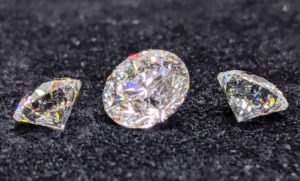
Which variety of diamond is right for you? You are probably debating between traditional mined-diamonds and the increasingly popular, lab-grown diamond. We want you to be able to make the best decision based on the facts—so we will share some of the current similarities and differences between the two.
A commonly asked question is: Do mined diamonds and lab-grown diamonds look the same? The answer is YES. If both styles of diamonds are in front of you, you wouldn’t be able to tell the difference between them with the naked eye.
Each comprises entirely of the element carbon under extreme pressure. Both mined diamonds and lab-grown diamonds can range in degrees of color from colorless to varying hints of yellow. They can come with just a few inclusions (flaws) to several within the stone. They come in identical shapes and placed into the same settings. So, lab-grown diamonds are officially the real thing and are indeed a real diamond. Both are diamonds; however, the FTC requires us to refer to lab-grown diamonds as lab-grown diamonds.
If Lab-Grown Diamonds are Real Diamonds, Then What Is the Difference?
Mined Diamonds
These stones form over a few billion years deep within the surface of the earth under extreme pressure and temperature. Mined diamonds require the work of large mining operations due to their location deep within the earth’s crust. The majority of the operations offer proper working conditions that require government oversight. They employ a large number of miners/communities whose sole income comes from the excavation of these natural stones. Mining is the only way many can make a living, and it’s vital to the local economy. Mined diamonds are also becoming more expensive to mine, which means prices continue to appreciate and continue to retain their value over time. No two mined diamonds are exactly alike.
Lab-Grown Diamonds
Unlike the mined stone, these diamonds form in a matter of weeks in a controlled laboratory environment by small groups of scientists and lab technicians. The lab will place the element carbon under high-pressure and high-temperature to form a diamond crystal; this is High Pressure, High Temperature (HPHT). Another way would be through Chemical Vapor Deposition (CVD). During this process, the lab will take a small seed of a diamond crystal and grow it layer by layer. Ethically minded individuals gravitate towards lab-grown diamonds as they eliminate any worries about ethics. Over the long-term, lab-grown diamonds may continue to depreciate, which will impact the value; this is a significant consideration when comparing which stone is right for you. Also, these diamonds may lose their mystique due to mass production.
Price
Price is the leading difference between lab-grown and mined diamonds and why they are becoming increasingly popular. Lab-grown diamonds can cost upwards of 20%-40% less than mined diamonds of similar color, clarity, size, and weight. This price variance is due primarily to the low overhead, supply chain, and the ability to quickly reproduce new stones.
Now you can make a more informed decision on what is most important to your needs, style, and budget.
Why Josephs Offers Both Lab-Grown & Natural Diamonds
Josephs offers a variety of diamonds and lab-grown diamonds to choose from for your next Gold Box Moment. Our knowledgeable staff will walk you through the process and further discuss the advantages and disadvantages of both stones. Our goal is that you’ll be confident your happily-ever-after gem will last a lifetime.



